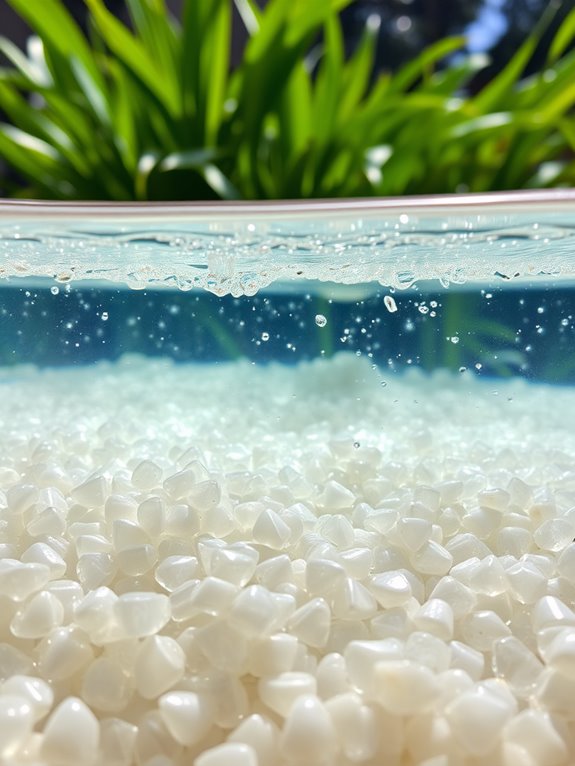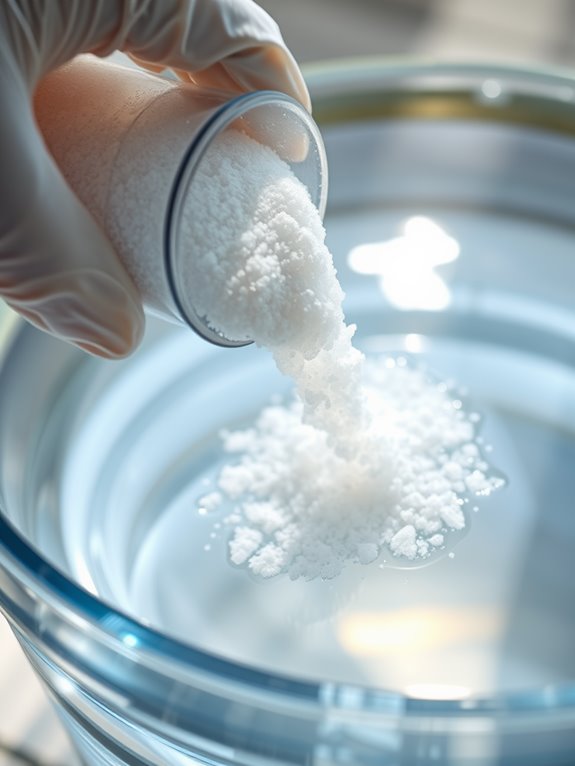Alum in Water Treatment: What It Does and How to Use It Safely
Alum, or aluminum sulfate, acts as a powerful coagulant in water treatment by clumping impurities together for easier removal, improving clarity and safety. When using alum, you should wear protective gear like gloves and goggles, and store it properly to prevent accidents. It’s essential to monitor the dosage to minimize environmental impact. If you want to explore how alum works in detail and its alternatives, there’s a lot more to discover.
What Is Alum and Its Role in Water Treatment

Alum, a chemical compound known as aluminum sulfate, plays an essential role in water treatment processes.
It acts as a coagulant, helping to clump together tiny particles and impurities in water. When you add alum to water, it binds with these particles, forming larger aggregates that can be easily removed.
This process enhances water clarity and reduces turbidity, making it safer for consumption. You’ll often find alum used in municipal water treatment facilities, swimming pools, and even home water filtration systems.
Understanding its role can help you appreciate the significance of clean water in your daily life.
You might also be interested in: What Does a Plumber do on Daily Basis? Inside the Life of a Plumbing Pro
The Chemistry Behind Alum in Water Treatment
When water treatment facilities add aluminum sulfate, they initiate a complex chemical process that effectively enhances water quality.
The aluminum ions released from alum hydrolyze in the water, forming aluminum hydroxide. This precipitate attracts and binds with suspended particles, including dirt and bacteria, creating larger aggregates called flocs. As these flocs settle, they remove impurities from the water.
The pH levels play an essential role in this process, as they influence the solubility of aluminum compounds. By controlling these conditions, you can optimize the coagulation and flocculation processes, leading to clearer and cleaner water for consumption.
Don’t miss out on related tips: Read this next: Are Water Treatment Plants Safe? A Deep Dive Into Water Safety
Benefits of Using Alum in Water Purification

Using alum in water purification offers several significant advantages that enhance both effectiveness and efficiency.
First, it effectively removes suspended particles, improving water clarity. You’ll notice that alum helps in coagulating impurities, making them easier to filter out. This process also reduces harmful microorganisms, contributing to safer drinking water.
Additionally, using alum is cost-effective, making it accessible for various water treatment applications. It’s relatively easy to handle and apply, ensuring you can implement it without extensive training.
Here’s another post you might find useful: How Does a Water Treatment Plant Work? Step-by-Step Process
How to Properly Dose Alum for Water Treatment
Dosing alum correctly is essential for effective water treatment. Start by testing your water to determine the turbidity level. Typically, you’ll want to add 10-50 mg/L of alum, depending on the clarity of the water.
Dissolve the alum in water before adding it to your treatment system to guarantee even distribution. Mix it thoroughly to promote floc formation.
Monitor the process closely, adjusting the dose as needed based on the results of your tests. Always record your measurements for future reference.
Here’s another post you might find useful: Are Water Treatment Plants Considered Industrial? Key Facts to Know
Safety Precautions When Handling Alum

When handling alum, you need to prioritize safety to protect yourself and others.
Always wear the appropriate personal protective equipment, store alum correctly, and know the emergency response procedures in case of an accident.
These precautions guarantee a safer working environment and help prevent mishaps.
Personal Protective Equipment
Although handling alum is crucial for effective water treatment, it’s important to prioritize safety through the use of appropriate personal protective equipment (PPE).
Wearing the right gear helps minimize risks and guarantees your well-being. Here are some key items you should use:
- Safety goggles to protect your eyes from splashes
- Nitrile gloves to prevent skin contact
- A dust mask or respirator to avoid inhaling particles
- Long-sleeved clothing to shield your skin
Proper Storage Guidelines
Proper storage of alum is essential for maintaining its effectiveness and ensuring safety.
Keep alum in a cool, dry place, away from direct sunlight and moisture. Use airtight containers to prevent contamination and clumping.
Make sure to label containers clearly with the contents and any hazard warnings. Store it out of reach of children and pets, and avoid mixing it with incompatible materials.
Regularly check for any signs of damage or leaks in the packaging. Following these guidelines will help you handle alum safely and maintain its quality for effective water treatment.
Safety always comes first!
Emergency Response Procedures
Even with careful storage, accidents can happen, so it’s crucial to know how to respond effectively.
Here are some key steps to follow in an emergency involving alum:
- Wear protective gear: Always use gloves and goggles to prevent skin and eye contact.
- Contain spills immediately: Use absorbent materials to soak up any spilled alum.
- Ventilate the area: Guarantee proper airflow to disperse any dust or fumes.
- Report the incident: Notify your supervisor or emergency personnel for further assistance.
Here’s another post you might find useful: Does a Water Filter Go Before or After a Softener? Best Practices Explained
Environmental Impact of Alum in Water Treatment
As communities increasingly rely on alum for water treatment, it’s essential to evaluate its environmental impact.
While alum effectively clarifies water, its usage can lead to increased aluminum levels in nearby ecosystems. This can disrupt aquatic life, particularly in sensitive habitats.
Additionally, alum can contribute to soil degradation if not managed properly, affecting plant growth. You should monitor alum dosing to minimize runoff and avoid over-saturation in water bodies.
Understanding these effects helps guarantee that while you’re treating water effectively, you’re also safeguarding the environment for future generations. Responsible use is key to balancing water quality and ecological health.
You might also be interested in: What Is a Ballast Water Treatment System? Definition, Benefits, and Technology
Alternatives to Alum for Water Treatment

What options do you have when it comes to alternatives to alum for water treatment?
You’ve got several effective choices that might suit your needs better.
Consider these alternatives:
- Polymer coagulants – These synthetic options can be more effective in specific water conditions.
- Ferric sulfate – A widely used coagulant that’s often favored for its lower residuals.
- Lime – Useful in softening water and removing impurities.
- Activated carbon – Great for adsorbing organic compounds and improving taste and odor.
Explore these alternatives to find the best fit for your water treatment process while ensuring safety and efficiency.
Regulatory Standards for Alum Usage in Water Treatment
When considering the use of alum in water treatment, it’s important to understand the regulatory standards that govern its application.
The U.S. Environmental Protection Agency (EPA) and the Safe Drinking Water Act set limits on alum residues in drinking water. You should verify that your alum dosage complies with these regulations to maintain water quality and safety.
Regular monitoring and testing are crucial to confirm that alum levels remain within acceptable limits. Always consult local regulations, as they may have additional requirements specific to your region.
Following these guidelines helps you use alum effectively and safely in water treatment processes.
Conclusion
As you explore the world of water treatment, remember the power and responsibility that comes with using alum. While it offers effective purification, the stakes are high—your safety and the environment hang in the balance. Picture the crystal-clear water you could achieve, but also consider the potential risks. Will you take the plunge into alum’s benefits, or will you tread carefully, weighing your options? The choice is yours, and it could make all the difference.


